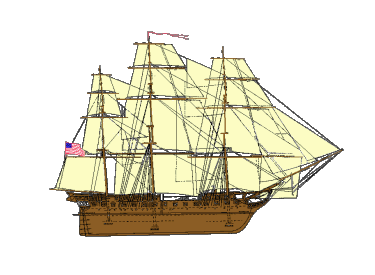






Joshua Humphreys designed these frigates to be the Navy's capital ships, larger and more heavily armed than the standard run of frigate. Humphreys had two criteria to satisfy, to out gun the next rate ship and to out-sail adversaries. Humphreys understood that optimization of the two criteria became mutually exclusive when building a hull. Combining the weight of the guns and the buoyancy curve of a fast sailing hull results in a force that distorts the hull. The distortion known as "hog" is the bending along the length of the keel. With minimal buoyancy, the ends of the ship tend to drop down under the weight loads of the guns, while the center midbody, being more buoyant, rises upward.
Humphreys recognized the need to stiffen the hull to resist the forces causing hogging. The successful integration of the two design criteria demanded an innovated technical solution to the problems of strength of materials and hull design. Built in Boston of resilient live oak, Paul Revere forged the copper spikes and bolts that held the planks in place and the copper sheathing that protected the hull. Thus armed, she first put to sea in July 1798 and saw her first service patrolling the southeast coast of the United States during the Quasi-War with France. In 1803 she was designated flagship for the Mediterranean squadron under Captain Edward Preble and went to serve against the Barbary States of North Africa.By early 1812, relations with Great Britain had deteriorated and the Navy began preparing for war, which was declared June 20. Cruising off the Gulf of St. Lawrence on 19 August under the command ofCaptain Isaac Hull, Constitution encountered the Guerriere, , a fast British frigate mounting 49 guns. Twenty minutes later Guerriere was a dismasted hulk, so badly damaged that she was not worth towing to port. Hull had used his heavier broadsides and his ship�s superior sailing ability, while the British, to their astonishment, saw that their shot seemed to rebound harmlessly off Constitution�s hull � giving her the nickname 'Old Ironsides'. It was a dramatic victory for America and for Constitution. In this battle of only half an hour the United States "rose to the rank of a first-class power"; the country was fired with fresh confidence and courage; and union among the States was greatly strengthened.
An examination in 1830 found her unfit for sea, but the American public expressed great indignation at the recommendation that she be scrapped, especially after publication of Oliver Wendell Holmes� poem 'Old Ironsides'. Decommissioned in 1882, she was used as a receiving ship at Portsmouth, N.H. She returned to Boston to celebrate her centennial in 1897.
In 1905, public sentiment saved her once more from scrapping. In 1925 she was restored, through the donations of school children and patriotic groups, and recommissioned in 1931. In 1941, she was placed in permanent commission, and an act of Congress in 1954 made the Secretary of the Navy responsible for her upkeep.
Now the oldest US warship still in commission, Constitution remains a powerful reminder of the nation�s earliest steps into dominance of the sea.
The USS Constellation in Baltimore is the 1854 sloop-of-war, bearing the same name as the famous frigate of 1797, as well as perhaps a handful of timbers taken from the frigate and installed for sentimental purposes. In 1968 she was restored and configured to resemble the 1797 frigate Constellation which was built in Baltimore. The exterior appearance of the ship was altered to simulate the 18th century frigate, with an open spar deck. An extensive restoration of the ship in the mid-1990s includes the removal of anachronistic features installed since 1955, along with others installed as early as 1913, to configure the ship as it appeared at the beginning of the Civil War.
Specifications | |
| Builders | Col. George Claghorn, Edmond Harrt's Shipyard, Boston, Mass. |
| Unit Cost | $302,718 (1797 dollars) |
| Power Plant | 42,710 sq. ft. of sail on three masts |
| Length | 204 feet (62.16 meters) (billet head to taffrail); 175 feet at waterline (53.32 meters) |
| Beam | 43.5 feet (13.25 meters) |
| Mast height | foremast, 198 feet (60.33 meters); mainmast, 220 feet (67.03 meters); mizzenmast, 172.5 feet (52.56 meters) |
| Displacement | 2,200 tons |
| Speed | 13+ knots ( approx. 14.95 miles per hour, 24 km. per hour) |
| Crew | 450 including 55 Marines and 30 boys (1797) |
| Armament | 32 - 24-pounder long guns; 20 - 32-pounder carronades; 2 - 24-pounder bow chasers. |
| Boats | one 36-ft. long boat; two 30-ft. cutters, two 28-ft. whaleboats; one 28-ft. gig; one 22-ft. jolly boat; one 14-ft. punt. |
| Anchors | two main bowers (5300 lbs.); one sheet anchor (5400 lbs.); one stream anchor (1100 lbs.); and two kedge anchors (400 to 700 lbs). |
| Date Deployed | October 21, 1797 |


